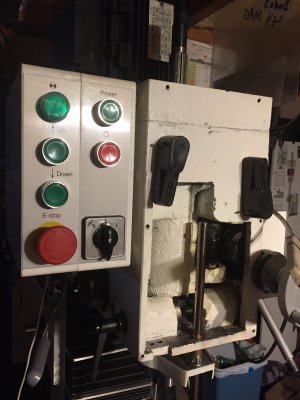I have been doing more brainstorming while scouring the internet looking for alternatives and materials to use and going through my materials on hand to see if I can make this stop with what I have. I have pretty much ditched the idea of using the 1/2-20 threaded rod in-line with the quill because I do not see there being enough vertical travel. I want there to be a solid flat surface for the quill stop but that will take up more of the already limited travel.
What I don't like about the PDF heads is that the hole for the quill depth stop is very close to the edge of the casting although I am finding the location and size of this hole vary depending on when it was built and the name on the machine. For instance Stefan's Optimum branded mill which was built many years ago has a smaller 16MM bore located deeper into the head and there is a boss that protrudes below the base of the head casting. The same goes for the slotted hole on my quill ring. The slot is cut close to the edge of the face and this leaves little material for strength so I will be adding a steel insert (basically the same design as darkzero's) that sits in the pocket of the quill ring after I machine the rough casting.
I am pretty much set on building a quill stop very much like Stefan's and I think I am also going to add a dial indicator as well. My though is that although I already have a digital readout to assist in monitoring the depth of the quill it wont work with the depth stop as accurately. I have thought about ditching the Z-axis scale for the head height and cutting down the scale and putting it on the depth stop. I feel that the Z-axis scale will get very little use but somehow I think I will regret it so this option alone has slowed down my progress because I am trying to figure the pro's and con's of this option.
What I am in the process of doing right now is cleaning up the rough casting inside the head where I would I am going to be making a positive stop for the adjustable stop. I want to keep it as short as possible and there are tall flashings that need to be removed. I will keep this updated with my future progress.
What I don't like about the PDF heads is that the hole for the quill depth stop is very close to the edge of the casting although I am finding the location and size of this hole vary depending on when it was built and the name on the machine. For instance Stefan's Optimum branded mill which was built many years ago has a smaller 16MM bore located deeper into the head and there is a boss that protrudes below the base of the head casting. The same goes for the slotted hole on my quill ring. The slot is cut close to the edge of the face and this leaves little material for strength so I will be adding a steel insert (basically the same design as darkzero's) that sits in the pocket of the quill ring after I machine the rough casting.
I am pretty much set on building a quill stop very much like Stefan's and I think I am also going to add a dial indicator as well. My though is that although I already have a digital readout to assist in monitoring the depth of the quill it wont work with the depth stop as accurately. I have thought about ditching the Z-axis scale for the head height and cutting down the scale and putting it on the depth stop. I feel that the Z-axis scale will get very little use but somehow I think I will regret it so this option alone has slowed down my progress because I am trying to figure the pro's and con's of this option.
What I am in the process of doing right now is cleaning up the rough casting inside the head where I would I am going to be making a positive stop for the adjustable stop. I want to keep it as short as possible and there are tall flashings that need to be removed. I will keep this updated with my future progress.
@9t8z28 I have PM932M and I'm looking to do the same thing.
What's the progress or your final solution?

